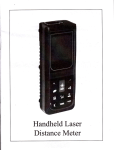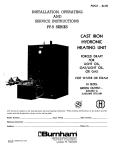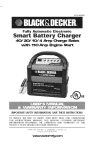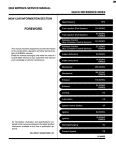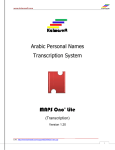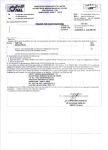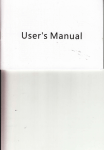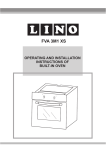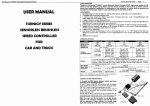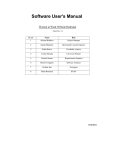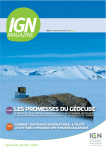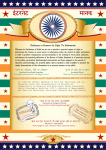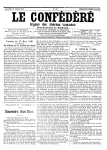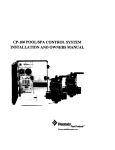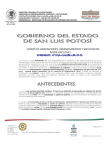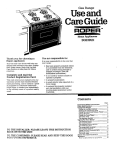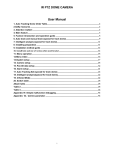Download IS 9249-1 (1979): Safety requirements for indicating and recording
Transcript
इंटरनेट मानक Disclosure to Promote the Right To Information Whereas the Parliament of India has set out to provide a practical regime of right to information for citizens to secure access to information under the control of public authorities, in order to promote transparency and accountability in the working of every public authority, and whereas the attached publication of the Bureau of Indian Standards is of particular interest to the public, particularly disadvantaged communities and those engaged in the pursuit of education and knowledge, the attached public safety standard is made available to promote the timely dissemination of this information in an accurate manner to the public. “जान1 का अ+धकार, जी1 का अ+धकार” “प0रा1 को छोड न' 5 तरफ” “The Right to Information, The Right to Live” “Step Out From the Old to the New” Mazdoor Kisan Shakti Sangathan Jawaharlal Nehru IS 9249-1 (1979): Safety requirements for indicating and recording electrical measuring instruments and their accessories, Part 1: Common safety requirements for instruments [ETD 12: Measuring Equipment for Basic Electrical Quantities] “!ान $ एक न' भारत का +नम-ण” Satyanarayan Gangaram Pitroda “Invent a New India Using Knowledge” “!ान एक ऐसा खजाना > जो कभी च0राया नहB जा सकता ह” है” ह Bhartṛhari—Nītiśatakam “Knowledge is such a treasure which cannot be stolen” IS : 9249 ( Part I ) - 1979 ( Reaffirmed 2002 ) Indian Standard SAFETY REQUIREMENTS FOR INDICATING AND RECORDING ELECTRICAL MEASURING INSTRUMENTS AND THEIR ACCESSORIES PART -. I COMMON FOR SAFETY REQUIREMENTS INSTRUMENTS ( First Reprint JANUARY UDC . 621’317.7 1990 ) : 614’8 ’ 0 Copyright 1980 RUREAU MANAK INDIAN OF BHAVAN. 9 BAHADUR NEW Gr 6 .- DELHI STANDARDS SHAH ZAFAR MARG 110002 February 1980 ISt9249(PartI)-1979 Indian Standard SAFJWY REQUIREMENTS FOR INDICATING AND RECORDING ELECTRICAL MEASURING INSTRUMENTS AND THEIR ACCESSORIES PART I COMMON SAFETY REQUIREMENTS FOR INSTRUMENTS Electrical Instruments Sectional Committee, ETDC 48 ChUinlIn PRO? ( DR ) J. K. C~XOUDHURY Jadavpur University, Calcutta Members SHRI V. K. BATRA SHRIJ. L. CHHABRA Roprrsenting National Physical Laboratory ( CSIR ), New Delhi Directorate General of Supplies & Disposals ( Inspection Wing ), New Delhi SHRIJ. S. P-1 ( Altsmat~ ) CHIEF ELECTRICAL ENGINEERResearch, Designs & Standards Organization, Lucknow ( CENTRAL RAILWAY) ADDITIONAL CHIEFELEOTRICAL ENGINEER (CENTRALRAILWAY ) (Alt.srnak ) Development Commissioner,Small Scale Indu.qt&, SHRlA. N. Gnose Mmistry of Industrial Development, New Delhi SHR~P. P. MALHOTRA( Altrmute) National Test House, Calcutta S~RIB.P.GHOSH Shanti Electric Instruments,Bombay SHRINARENDRAGOLNA SHRIH. S. SAWARKAR ( Al&mats) InstrumentationLtd, Kota SHRID. A. GOPA~&RISHNA SHRIC. S. DANE(Alternate) Institute for Design of Rleet&ol M&wing I~~SHRIK. V. GOPALRATNAM mcnts,Bombay DR N. VANVARI( Akrzatc) SHRIK.B.KAMAT Dii~~m~%~on-&nZ&ts~ :w%L’ SHRI V. C. SAXENA ( Alfarnatr) Central scientific SHRIM.R. KATARIA Instnmlents orga&ation ( CSIR ), Cbandigarh ( conrinurdels~go 2 ) 6D copyrlglrf 1980 BUREAU OF INDIAN STANDARDS This publication is protected under the Indian Copyrig&r Act reproduction in whole or in part by any means except with writ publisher shall be deemed to be an infringement of copyright ISr9249(Partf)-1979 ( continnui~owxpoge 1) Repmenting Department of Induatrics, Government of Punjab, Chandigarh Members SHRI K. L. KORLI SAN PARMINDRR COL K. V. KUDVA fhNOR ( b6TRBtr Ssi~rG.R.G~orur(d) Sanr S. D. Kutunnr COL C. D. MALANEY ) controllerate of Inapcction Elcctrollicd ( Minktry of Dcfcncc ). Ban&ore All India Ii rumcnt Manufacturers’ & Dealers’ Association. Bombay Dhwtct~~Standardption, Ministry of Deface, Smu C. K. V. RAO ( &&mate) Automatic Electric Ltd,.Bombay !kiuC.R.Mxsxi~~ SHRI0. P. PIIRI( Allmratr) ) Dcpartmeslt of Industricr and Commerce, Govcrn.SsmuE.N. F~ARAYANAswA~~ mcnt of Tamil Nadu, Madrar SHRXC. NATARAJAN ( dltemote ) The Bombsy Electric Supply and Transport UndcrSRRX V. H. Nnv=u taking, Bombay SEXRI S. P. BWOTA ( &HlUt6 ) Indii~mb~~ectrical Panufacturen’ Assaciation, DUG.M.PEADKS SEN Ix; s. vmvEswAMlAE ( Altenla&) SstuK.N. RAMMWAYY Dii~~cto;ccncrd Smu R. S. SOUNDHRARAJAN ( Altenwte ) Ork~ttSdcnce SEW hKSEM SACbAR of Technical Apparatus Development, Workshop, Ambala SXRXK. S. GOPTA(dlternotc ) The‘ Motwane Manufacturing Co Pvt Ltd, Cyan Smu DXNESH N. SAPBAHI Baug, Maharashtra -To&&al Industries Pvt Ltd, Ajmu DRG.R. T-AL !&m&C. &&ULESEWARI(~&~~) B&s& Heavy Electricals Ltd, Shopal SRRI M. S. WANDALXAR SanrS.K. KMGIWAL(A~~~M~~) Director General, IS1 ( Ex-o$ciu Member‘) smus.P.sAQwEv, Director ( Elcc tech ) : KMG.M.JOSEPH Auirtant Director ( Elcc tech ), IS1 2 18:9249(aut1).1!479 Indian Standard SAFETY REQUIREMENTS FOR INDICATING AND RECORDING ELECTRICAL MEASURING INSTRUMENTS AND THEIR ACCESSORIES PART I COMMON SAFETY REQUIREMENTS FOR INSTRUMENTS O.FOREWORD 0.1 This Indian Standard was adopted by the Indian Standards Institution on 30 July 1979, after the draft finalized by the Electrical Instruments Sectional Committee had been approved by the Electrotechnical Division Council. 0.2 This standard ( Part I) spccitks common safety requirements for indicating and recording instruments and their accessories so as to ensure reasonable personal protection and protection against damage to the surrounding area. The safety of the instrument depends also upon matching its design to the installation where it is used. 0.3 This standard ( Part I ) covers only common safety requirements applicable to electrical measuring instruments. Part II of this standard will be dealing with safety requirements for instruments using a mains supply. Special safety requirements for instruments for use in particular environmental conditions would be added to the individual relevant “,I specifications. 0.4 In the preparation of this standard ( Part I ) considerable assistance has been derived from IEC Pub 414 ( 1973) ‘ Safety requirements for indicating and recording electrical measuring instruments and their accessories ‘, published by the International Electrotechnical Commission. 0.3 For the purpose of deciding whether a particular requirement of this standard is complied with, the final value, observed or calculated, expressing the result of a test, shall be rounded off in accordance with IS : 2-1960*. The number of significant places retained in the rounded off value should be the same as that of the specified value in this standard. *Rulea for rounding off numeriul values ( mid). 3 IS f 9249( Part I ) - 1979 1. SCOPE . 1.1 This standard ( Part I ) covqrs common safety requirements for compliance to the following electrical and electrically measuring instruments: a) Direct acting indicating insbuments; b) Direct acting recording instruments; c) Indirect acting instruments; and d) Certain accessories used with these instruments. and tests operated 1.1.1 This standard does not cover special requirements for instruments for use in particular environmental conditions, such as weather-proof, shockvibration-proof instruments, intrinsically safe proof, explosion-proof, instruments or instruments for medical application. 1.1.2 This standard also does not cover requirements requirements of indicating and recording instruments. other than safety 2. TERMINOLOGY 2.0 For the purpose of this standard the following definitions shall apply. 2.1 Instruments 2.1.1 Fixed Instrument - AIT instrument designed to be permanently mounted on a support and which is intended to be connected to an external circuit by means of permanently installed leads. 2.1.2 Portable Instrument easily carried by hand. NATEuser. The instrument An instrument is intended to be connected specifically designed and disconnected easily part or an assembly of parts which 2.1.3 Electronic Dtvict -A electron or hole conduction in semiconductors, gases or in vacuum. to be by the uses A terminal directly conrlected to a 2.1.4 Measuring Earth Ttrminalpoint of a measuring or control circuit or to a screening part which is intended to be earthed for measurement purposes. to spccifizd 2.1.5 Prottctivt Earth Terminal - A terminal connected conductive parts of an instrument for safety purposes, to be connected to an external protective system. 2.2 Circuit Terms 23.1 Supply Mains supply one instrument. Any power source which is not us&d solely to NOTE - This definition does not relate to the measured quantity but to the supply mains when it is used to energize auxiliary circuits of the instrument. 4 Ist9249(P&tI)-‘I979 23.2 Nominal &cait Voltage ( circuit Ins&ion vobag6 ) - The high& voltage with respect to earth which may be applied to a circuit of the ‘n&rument is unlikely to beco,me dangerous to touch. wmtructed from the 2.2.3 Saf6& exka-low Vobp - A nominal voltage between conductors and between conductors and &th not exceeding 32 V between conductors, or in the ‘case of three phase c&its not exceeding 18.5 V between conductors and neutral. When tity atrAnv voltage in obtained from a rupply maina ofhigher NORvoltage, a safety ( isolating ) tramformor or a convertor with repsrate windi a*+ ormar The voltage liim 8rc then bucd on the assumption that the a* rupplkd 8t ita rated volw 2a2e3.I l&&a-low dtag6 - i voltage: generally having the same limits is safety extra-low voltage but without any rcstrictionr on the method of obtaining it. 2.3 ConstructionaI Terms 2.3.1 Clewan& - The conductive shortest distande measured in air between parts. ,2.3.2 Cre6pag6 Distanc6 - The shortest distance surface of insulation between conductive parta. measured over the 2.3.3 BJ Hand - An operation which does not require the use of a tool, coin or any other object. 2.4 SaMy Terms 2.4.1 Accessi Part of an Instrument - A part which may be touched by the standard test finger when the instrument is ready for use. NOTE- 6 Ready for use ’ for a 6ped tutrument denotea that it ir ap ropriatcly mounted on its support. Tberefo~, 6x4 inrtrummtrrare characterized by :: e fact that one part of the instrument may be acceasibk when ready for use, while the 0th~ part is inaccessible. 2.43 Instrument ?lrithout Accrssiblr Conductivt?Parts - An instrument in which all parts other than terminals, that are accessible when the instrument is ready for use, are made of insulating material, except minor parta such as name-plates, screws or rivcta which are isolated from measuring and/or auxiliary circuits ($66 5.1.1). 2.4.3 Instrument with Ace&b& Con&&m Parts - An instrument in which conductive parts are accessible when the instrument is ready for use. Small parts, such as name-plates, screws or rivets, which are isolated from measuring and/or auxiliary clrcuifs, and also terminals are not considered to be accessible conductive parts ( sbc 5.1.1). , 5 2.4.4 Live Part - A part, contact with which’ may cause a rignifiaukt dcctric shock (se6 5.13). 2.4.5 InuctizuPart - A art which is capable of carrying voltage current but is not so used Buring correct operation of the instrument. or 2.4.6 U.waf~ Tmnptiatwr - A temperature likely to cause burns and/or which may cause’ the operator to perform an involuntary dangerous movement. 3. GENERAL REQ~MENT6 AND ‘f’Efi* PRCKIEilURE 3.1 GenerpT ReqPircmcnta - The instrument shall be so designed and constructed as not to present danger either in no&al._~e,or under specSed overload conditions and especially to ensure personal s&ye$! againsu a) electric shock, b) unsafe temperature, c) spread of fire. 3.2 General and, Test Conditions 3.2.1 Compliance with the requirements out all the tests specified. shall be checked by carrying NOTE- Whenever particular tc3tsare indicated io more than one of the following c)llures,this does not necessarilyimply that the teatshall be carried out more than once. 3.2.2 The tests are type tests unless otherwise specified. A type test once carried. out successfully on a particular type of instrument may be held to be valid for other instruments of the same design, having different measuring ranges. The type test shall be carried out on an instrument having the measuring range which is the most liable to fail of that design of instrument. 3.2.3 The tests specified in the foljowing clauses shall be carried out on unused instruments in the condition as supplied. 3.2.4 Unless otherwise specified, the following conditions ahall prevail in the test location: a) Ambient temperature between 15 to 35%; b) Relative.humidity not outside the range of 45 to 75 percent; c) Air pressure between 86 to 106 kPa; and d) Without duw, hoar-frost, percolating water, rain, solar irradiation, etc. 3.2.5 Tests shall be carried out on the complete instruments, that is with case and covers in position and the necessary accessories appropriately connected. 6 When an instrument has non-interchangeable accessork, they shall b connected to the instrument in the normal manner use,and the tests Interchangeable acce&uies and shall be carried out on the combination. accessories of limited interchangeability shall be subjected to sefjnrate tests relating to their own characteristics. of 4. HEATING 4.1 ContraI:When under continuous load or continuous overload, no part of the instrument shall reach a temperature that may cause fire, or a hazard by physical contact with accessible parts, or deformation_ of, the enclosure ( including transparent windows ) when subjected to external forces. Compliance shall be checked under the averload, conditions specified in the relevant standards. ts which an not designecl for co6@m6w operation or continNOTE- Inatoverload are to be operated in their permissible mode of epaatien in su& a manner that the greatest poasiblc heating occun, 4.2 Accessible Parts-When the instrument is under the conditions specified in 4.1, the temperature rise of any part which is accessible when the instrument is ready for use shall be measured. TM temperature rise shall not wcced: a) For accessible metal parts b) For other accessible p&ts 25°C 35°C If higher tempertures shall occur, the provisions of 93.4 shall apply. 4.3 Ptrmantnct of Indation -Neither the insulation strength nor the creepage distances and clearances, if specified, shall be permanently and inadmissibly reduced,, when the instrument is operated under the conditions specified in 4.1. After the test, and also when the instrument has cooled down to its initial temperature, it shall show no damage which might impair its safety as specified in this standard. Compliance shall be checked by inspection tests specified in 5.5, 5.6 and 9; and by performing the 4.4 Mtthanicd Strength at Elevated Ttmptratures -When the instrument is under the conditions specified in 4.1, the rigid test finger specified in Fig. 1 shall be applied with a force of 30 N directed inwards to different points of the surface for 10 seconds each time. Nora-- For iartrumentswith a dotu this test ia not to be applied to delicate parts ( for exampl< the mechanism -of record’& instrumenta ) which become acccsqiblc when the door C opened. The instrument shall show no deformation safety as specified in this standard. 7 which might impair its m-tm?l( eaitl)-am uk !BJ.l L&c pa&‘a+ll not:bc acqasible when tbc imtmimnt is ray Live parts &al& tbcrcforc, be protected by covering or i@ation. fbr In order to determine whctbcr a part is acccmiile, either &al inrpcctionrballbcwcdortbe.jointcd t~ingcrortherigidtat sbow1~311F’iircs 2 and 1 Fespectively, shall bc applied. In case ofvcr out tbc latter shall be applied with a maximum tbrcc of 30 N. NOTE-An mcommcnded cktrical contact hdiatian with l vohgc ofappm&uatd~ to show contact with wnductive parts. ,, 4OV ir This test is ap$ied: a) For Jixdd instrummts- Only to those parts, which are accessible from the front when the instrument ir mounted ready for use. b) For 0th~ instmmts - To all outer surfties including the base. 5.1.2 The requirements of !I., .I do not apply to external terminals and sockets of measuring circii$: if they are accessible for operational reasons. NOTE -These terminals should he protected +nst unintended contact possible by covering, recessing or by their poaitionmg and arrangement. as far as 5.1.2.1 For this test, measuring circuits are energized at their nominal circuit voltages ( circuit insulation voltages) above earth. One pole of a test source is connected to all the measuring circuit terminals joined together, and the other polo is connected to earth aud (if there is one ) to the earth terminal of the instrument. A voltmeter having an internal resistance of near to but not less than 50 ktz is connected between earth and any conductive part which may be live. The voltage of the test source is adjusted to be equal to the nominal circuit voltage (circuit insulation voltage) of the instrument. If the indication of the voltmeter does not exceed 15V, the conductive part is not considered to be live. In general, and especially for an instrument having a nominal circuit voltage ( circuit insulation voltage ) higher than the voltage between its terminals, it may be assumed that live parts are isolated from any accessible conductive parts, including an earth terminal, if provided. When an instrument has a measuring circuit connected to the earth terminal or to the enclosure, a test voltage equal to its rated voltage is The earth terminal and/or the enclosure applied between the terminals. are connected to earth and to one pole of the specified voltmeter. 8 SliOlNG FIT l.N HANDLE-I )r., FORCE INDICATOR (max. FORCE 30Nl PRING LOAOED Tolerance,: On an@ =b5 On linear dimensions: Less than 25: “p,, : f -2 Over 25 All dim&ions in millimetres. Fxo. II TEST FINGER, RIGID l-i /-4R s /NSULATlNG UAIERIAL SPHER XX SECTION (ENLARGED) CYL I’ ‘\ @ m SECTION YY SECTION I‘Ic. 2 TEST FISC-F : 9 ZZ lENLb.RGEDb (ENLARGEDI + ‘\ ’ I-50 6-4 - 1889249 (PartI)The test circuits are shown in Figures 3 and 4. TEST ‘I\ VOLTAGE SOURCE TEST VOLTAGE SOURCE t\ L-PiWT TO BE TESTED The insti-ument with isolated ‘The instrumcnk with earthed measuring circuit measurirg c;rcuit FIG. 3 CIRCUIT DIAQRAMFOR VOLTAGE TEST ?XG. 4 &RCUIT DIAGRAMFOR VOLTACE TEST 5.1.3 In order to determine whether a part is live, the following shall be carried out ( see also 5.L2.1). test When an instrument has an earth terminal,.it shall be earthed: a) Measuring circuits isolated from the case and from the earth termi& All the terminals of the measuring circuits shall be connected together and to one pole of a source of the nominal circuit voltage ( circuit insulation voltage ), the other pole of the source being earthed. 10 , If!MM!I(PartI)-197b b) Measuring circuits having II comae&on to the earth terminal and/or the case - The measuring circuits of the instrument shall be energized at their rated voltages. This test shall not be carried out with current circuits having a connection to the earth terminal. c) Instrumrnts hauing auxiliary cir&s - An additional test shall be circuits under their normal carried out by energizing the auxili condition of use, each pole of the sup “1, b being connected to earth L turn. N~TE~ -It fklm earth. may be necessary to ensure that the supply used for these tests is isolated The voltage between any accessi& conductive part and earth shall be measured by a voltmeter having an internal resistance of near -to but not less than 50 m. The part is not live if the voltage as measured in (a), (b) and (c) above does not exceed 15 v. NoTeZ - These values have been chosen so as to detect any accessible part having a voltage to earth exceeding 15 V and from which a current greater than 300 PA may be drawn. 5.1.4 Insulation used for protection against electric shock shall have adequate electrical and mechanical strength and shall be permanent. Tests for compliance may be agreed upon between the interested parties. b&5 External handles, knobs and the like, operating mains voltage carr@ng component parts, shall be made of insulating material, unless tliey d connected to those component parts by an insulating shaft or other insdating means. Compliance shall be checked by inspection. 5.1.6 Operatisg shafts shall not be live. Compliance shall be checked by performing thb ,tests Specified in 5.1.3 after removing knobs, handles and the like, unless t’ey are immovably fixed. 5.1.7 If a hole control requires a shall not involve setting the control gives access to preset controls and the setting of this screw driver or bther tool, the adjustment of the control the risk of a shock. .Compliqce shall be checked by with any suitable tool. The tool shall not becog. live. 5.2 Interior of the Instrument - Parts of instruments which become accessible by manual opening of a door or removal by hand of a cover shall not be live. Parts which become accessible during normal operation shall not be live, even when the cover or door is opened by a key or the like. Terminals and sockets are excepted according to 5.1.2. Compliance shall be checked by application of the test of 5.1.3. 5.3 &f&y Measures and Exemptions-Instruments shall be sd constructed that they comply with the requirements of 5.4 and will withstand the tests specified in 5.5 and 5.6. 11 The following types of instruments are exempted from’tht’ r&p&cments of the$e clauses provided that t&y arc marked w$h a figure. ‘0’ with 92. _ within a star in accorda& Instrumtints which are intended to be connected to ‘extra low a) voltage only ( below 32 V ), Nolg -This may apply to instnmcnts which are supplied by a battery. titruments with a built-in voltage generator (for example b) ohmmeters) .having a maximum steady-sate output current of 5 mA ac, 10 mA dc, or for a mixed current, 10 mA peak g&e. In addition, instruments which are marked with Symbol C-4 ( SII 9.3.2 ) are subjected to less severe voltage tests than specified in 5.5. NoTd-(_ Instruments, one terminal of which is connected to the cuclosure, shall’not be st$&cted to the tests apccifjed in 5.1 and 5.6 and special precautions are necessary when handling these instruments. 5.4 Connectlog to a Protective System 5.4.1 Inrtrumenti z&h A~e&bl~ Cmductiue Part - All accessible conductive. part@ which may become live due to faults s1 all be bondad together and also t6 the means for effective connectiod to a protective system. The means for the dffective connectioh to a protective system shall be provided in accordance with Table 1. Protective earth terminals shall comply with the requirements sPe&ied ip 8.2. Compliance shall be checked as routine test by inspection and, in cab of doubt, by measuring the resistance between the earth terminal and the accessible conductive parts. It shall not exceed 1Q. TABLE 1 MEANS FOR NOWNAL &KWIT VOLTAGE ( CmCmr INSULkTION VOLTAOE) CO NNRCTION FEUD IN~~RUMBNT~ Over 50 to 650 V Over 650 V OTHER SYSTEMS INsTRUIIEN28 (3) (2) (1) Up to and including 50 V* TO PROTECTlVR None NOtIC Means onlyt Protective earth terminal Protective Protective earth te.rmiml *For dc instruments for telecommunication applications, earth terminal the limit is urtendcd to 60 V. VMeans only’ denotes that an earth terminal is no1 mandatory method may be used. and that any effective NOTE - The methods are selected on the basis of the nominal circuit voltage of the measuring circuit or any auxiliary circuit whichever is greater. 12 5.62 I&tram&s wit&u& ACUSS codlrctio Parts-Ins&umentt witha nominal circuit voltage ( circuit insulation voltage ) exceeding 650 V which are totally onclaeed in insulating material shall have a protective earth tern&al connected to the inactive interior conductive parts unless those are protected by insulation, capable of withstandii the voltage. test specified in 53. CompIiancc appl ’ g r’tat ahill bq .&xkd- voltage‘spoci6ed P.for’ 5 spec&d in 5,5.2.1(d). by kption and, if necessary, by in Table 2~between the inactive parts and 5.5 VolwgeTestm 5&l Ce~4+By agreement between the manufacturer and the purchaser, instinmants may be rubjected,to a htimidity prccondiiiaing before p@brming voltage teats. 55.2 Poiflis i&dpjl*?J ofth Tist vdhlgr 5.5.2.1 The test voltage shall be .applied between all m+uring circuits connected tqgcthcr, and the reference test, earth joined to’ the auxiliary circuiti, ifany. The reference tat earth consists of one or more of the following: The earth terminal, if any; 4 b) For instruments with a conductive enclosure - this enclostire and pieces of conductive material in contact with it; 4 For,instruments with an insulating enclosure having accessible conductive parts, isolated from the electrical circuitsthe assembly of all of them connected together; 4 For insttimcnts with an insulating enclosurea metal foil covering the whole of the instrument and having a space only around the terminals and approaching them to within a distance of not more than: 1) with test voltages up to and including 10 kV: 20 mm, and 2) for higher test voltages, the distance shall be LO diplensioned that no flash-over occurs between. the foil and the terminals; and 4 The accessible components of the mechanical zero adjuster, of the index adjuster, and the range-changing switches, maintained at the same potential as the enclosure. Wrapping in a metal foil is advisable. 13 The voltage testrhalj be carried out as: 1) a routine test for (a), (b), (c) aud (e), aud 2) a type test for (d). 5.5.2.2 Inimnamb with smd cimdtr - When an instrument hat several circuits, an additional test shall be carried .out as ape&ted in a) and b) below: For wattmeters ( var-meters ) and phasemeters whale measuring circuits are intended to be connected to the same phaac, a test voltage of at least 500 V or twice the nominal voltage shall be applied between the current and voltage circuits; This test ir not applied when the current and voltage circuits are permanently joined together at one point. For wattmeters (var-meters ) having a winding wht”ch compensates for the consumption of the voltage circuit, the test voltage ia liited to 50 V. Then they shall be marked with symbol y-33 of Table 3. For instrqments whose measuring circuita may be connected in different phases ( for ekample, polyphasc or multiple instruments ) , The value a test voltage shall be applied between thao circuits. of this voltage corresponds to the nominal circuit voltage ( circuit insulation voltage ) speded in Table 2 which is equal to the rated voltage between phases or to the value immediately above it. The measuring circuits of a pollphase instrument which are connected to the same phase shall be subjected to the test specified in 5.5.2.2(a). c) When the instrument inch&d one or several akihary circuits, 8 voltage test shall be carried out by applying the test voltage specified in 5.5.3 between the auxiliary circuits and all the other circuits connected to the reference test earth (WI 5.5.2.! ). Auxiliary circuits which are energized at extra low voltage, and having one pole connected to accessible conductive parts or other inactive conductive parts of the instrument, are not subjected to this test. 5.5.3 Vaku qf the Test Voltage-The test voltage is determined in relation to. the nominal circuit voltage ( circuit insulation voltage ) of the circuit. This voltage is selected from the values given in Table 1 and, except as exempted by 9.3.2 shall not be less than:’ a) the upper liiit ofthe measuring range for voltmeters, b) the upper limit of the nominal range of use for wattmeters ( var-meters ), phasemeters and frequency meters, and c) 250 V for ammeters, unless otherwise specified. NOTE - For inat~ments which are intendal to be connected via instrument tranaformers, a nominal circuit volta e ( circuit insulation voltage ) of at last 650 V im recommended in orda to match 8l e general insulatiti la& of thae trauskmera. 14 For auxiliary circuits, the test voltage is a function only of the rated voltage of these circuits without taking account of the symbol for the voltage test. Then the rI2w value of the test voltage corrcspands to that nominal circuit voltage ( circuit%sulation voltage ) of Table 2 whore value is equal to or greater than the rated voltage of the auxiliary circuit. TABLE 2VG~~~~~ GIRGUIT VOLTAGE , -&~TgsTOLTAGE (clorru Noumfi t%RCUlT vo~lnaa ( Gmourr INsuLATIon VOLTAOX ) OF TnJrI4flrAsunlNo 5.4.2, 5.5.2.2, 5.5.3,5.5.4.3, PLAow IN STAR M AcXXXUM8~ wrrn 9.2 NUMBB~ (2) (1) No number l-5 2 50 :ztY : :g 3000 4000 65g Instruments specified 5.3 (a) and (b) ( URGUlT : ::: in 0 lN3ULATION OF 9.2) Tvsr Vo~rror M kV b-4 t (3) 10:,5 5:. 5-O z: 11.0 13.0 No voltage test *For a given type of instrument, the nominal circuit voltage (circuit insulation voltage ) of the measuring circuits is selected by the manufacturer from one of the values shown. The value chosen should not be less than the rated value or the nominal voltage of the measuring circuits of the instrument as specikd in 5.5.3. When it is higher, the instrument may be used in a circuit whose voltage to earth iscorrespondingly higher. For example: a) A voltmeter having a rated voltage of 10 V would normally have a nominal circuit volta e ( circuit insulation voltage ) of 50 V. b) A similar vo f tmeter could however be manufactured for a nominal circuit ( circuit of 1000 V. This instrument would still measure voltages up insulation voltage to 10 V but coul d do so in a circuit operating at up to 1 OMIV above earth without danger to the user. This type of voltmeter is currently used in the electrolysis of met&. tThe test voltage, which is a function of the nominal circuit voltage ( circuit insulation The value of the test voltage, voltage ) to which the instrument is subjected, is given. expressed in LV is marked on the instrument by a number inside a star. ‘For example, the voltmeters just mentioned would provide the user with th following informatton: a)Nonumberinridetherturhomtbptthevoltagerborcutthoftbemewring circuitislimitedto5OV,and b) The number 3 inside the star shows that the measuring circuit of the voltmeter may be operated at up to 1 tM0 V above earth witbout being dangerous to the user. Figures 5 and 6 show permissible methods of use of these two 10 V voltmeters. 15 Ulr!m9(PartI)-1979 :p7 V +-I r 1ov -1, e NORMAL FIG. 5 LIMITING USE USE EXAMPLR OF THR pkmaxsm~k USESOF A O-10 V VOLTMETRR MARKPD BY A STAR WITHOUT NUYBER --____--_-___ L.5 v r Cn 1 __-___- 1 q I cells Cl,% -.a* ti* I Electrolytic v,,v, . . . . Vn I cell voltmeten c * Supply8ourcefor thecells. FIG. 6 O-10 V VOLT~~RS MARICXD BY THE N-RR STAR [ NOXINAL CIRCUIT VOLTACII (CIRCUIT INSULATIONVOLTAQE) = 1000 V ] USE OF = INSIDE THE 3 5.5.4 Method of Test 5.5.4.1 TsSr voltage - Voltages tests shall be performed with a test voltage of substantially sinusoidal waveform; its frequency shall be between 45 Hz and 65 Hz. 5.5.4.2 CM of the availabk pmat of tAs Wing a$$aratus - The off-!oad voltage of the testing apparatus is initially set to 50 percent of the 6pecfied voltage. It is then connected to the instrument under test. The power of the supply source is considered sufficient when, it is such that the voltage drop observed is less .than 10 percent of that voltage. 16 .;s”’ r Isr9249prtI)-1979 5.5.43 Application of thv trst voltage- The test voltage shall be raised smoothly to its specified value in Table 2, by such steps that no appreciable transients occur, maintained for 1 minute and then lowered smoothly to zero. 5.5.5 Conclusionof the Test flashover shall occur. During the voltage test, no breakdown or 5.5.6 l&petitionof Voltage Tests - For repetition tests which are performed on unused instruments in the condition as supplied, the following apply, unless otherwise agreed to between the manufacturer and the purchaser: 4 Instruments, the test voltage of which does not exceed 2 kV, may be subjected to the necessary number of tests, each of them being performed at 100 percent test voltage; and b) For instruments the test voltage of which exceeds 2 kV, two tests are permitted ( that is, one repetition ), each of them at 100 percent test voltage. 5.6 Insulation Resistance Test - By agreement between the manuic turer and the purchaser, instruments may be subjected to a humidity preconditioning before performing insulatibn resistance tests. The insulation resistance shall be measured between all circuits connected together and the reference test earth as defined in 5.5.2.X. The test shall be carried out under the same conditions as the voltage test of 5.5.2.1, except that the auxiliary circuits shall be connected to the measuring circuits. The measurement of the insulation resistance shall be made 1 minute after the application of a direct voltage of about 500 V. The insulation resistance so measured shall not be less than 5 MQ. 6. PROTECTION AGAINST THE SPREAD OF FIRE 6.1 Insulation used for supporting parts intended to be connected to the supply mains, and insulation used as external covers and cases, especially those which support external terminals, shall be made of materials which do not involve danger under conditions arising from short circuits inside the instrument or from heat developed by external leads not properly fastened. These materials shall be such that they do not soften to such an extent as to impair the safety or to cause further short circuits, and shall be either non-flammable or self-extinguishing. Compliance tests may be agreed upon. shall be as specified in 29 of IS : 302-1973’. *Specification ( fwrth rmision ). for general and rafety requircmmts 17 TheLrecommcnded for light electrical tests applianca ISt9249(PartI)-1979 7. COMPONENT PARTS AND ACCESSORIES 7.0 In general, component parts of, and accessories used with, the Furthermore, instruments shall comply with their relevant requirement% the following requirements shall apply. 7.1 Moving Parts z Moving parts liable to cause personal injury shalt be so arranged or enclosed as to provide adequate protection in normal use against this danger. Protective enclosures, guards and the like shall have They shall not be removable by hand. adequate mechanical strength. Compliance shall be checked by inspection and by manual test. -Current circuits inside the instrument or 7.2 cudrent circuits accessory shall be so designed and constructed as to provide for adequate protection against any danger arising from interruption of these circuits Range changduring operation. Connections shall be securely fastened. ing switches in,corporated in the current measuring circuits shall be so designed that the current flow is not interrupted when these switches are operated. Compliance shall be checked by inspection prescribed in the relevant standards. NOTE --For particular in&umcnts,, more severe upon for the purpose of thii tert. 7 3 Batttrits accumulation after the overload overload conditik tests may be agreed -Batteries shall be so arranged that there is no risk of the of flammable gases. Instruments containing batteries holding liquid shall be so designed that safety may not be impaired by leakage of the liquid. Compliance ’ shall be checked by inspection. 7.4 Strew Connections -Screw connections transmitting contact pressure and screw fixings which during the life of the instrument are to be loosened and tightened readily, especially terminal screws and screws for fixing levers, knobs and the like, shall screw into a metal nut or metal insert. Compliance agreed upon. shall be checked by inspection. 8. CONNECTION Strength tests may he DEVICES s-Accessible screw terminals shall be so 8.1 Acctssiblt Tt =!-f enchored, fitted or designed that the fixed parts shall not work loose when the scre$va are tightened or loosened. Accessible screw terminals of portable instruments shall allow connection to be made with sufficient contact pressure without deterioration 18 lsss249 (Pad)-1979’ Furthermore, they shall allow a conductor to’ be of the conductor. connected without special preparation ( for example, soldering of the end of the conductor, use of cable lugs or bending of eyelets ) and shall prevent the bare conductors or strands of conductors from slipping out when the screws are tightened. Compliance shall be checked by inspection and by manual test. , 8.2 Protective Earth Terminals - For’protectivc earth terminals, the folknving shall apply: a) The earth terminal shall be at least of an equivalent size to tho live terminals and shall accommodate a conductor of the same size with a lower limit of 4 sq mm and an upper limit of 16 sq mm; b) AU parts of the earth terminals shall be such that there is no danger of corrosion resulting from contact with the copper of the earth conductor ( or any other metal in contact with them ); c) Except for portable instruments, if shall not be possible to loosen the earth terminal screw by hand; and d) The protective function shall not be interrupted by the presence of switching device or a fuse in the instrument or accessory. Compliance 9. MARKING’ shall be checked by inspection and by manual test. ~ In respect -of safety, the instrument accordance with 9.2 to 9.4. 9.1 General- shall be marked in The marking on the instrument shall be easily discernible, legible and indelible. The information shall be shown on the scale plate or on the exterior surface of the instrument. Marking according to 9.3 shall be visible when the instrument is ready for use. Compliance 9.2 Nominal Corresponding is checked by inspection as a routine test. Circuit Voltage ( Circuit Insolation Voltage ) and Test Voltage of the Measuring Circuits - The test voltage corresponding to each nominal voltage ) is given in Table 2. circuit voltage ( circuit insulation The value of the test voltage shall be marked on the instrument, inside a star, in accordance with Table 2. In the absence ofsuch a number inside the star, the test voltage is 0’5 kV. The figure ‘0’ within the star indicates that no voltage test is to be carried out. Symbols C-l to C-3 of Table 3 shall be used. 9.3 warning symbols - Warning symbols shall’ b/i discernible on the instrument when ready for use and shall contrast well with the background. 19 19~9%9CPart1)-1979 9.3.1 14 to ensure that there is no danger to the instrument in use, it is necessary for the user to refer to the instruction manual, the instrument shall be marked with Symbol F-33 of Table 3. with this rymbol does not exempt NoTa -Marking requirements contained in this standard. the imtrummt from any safety 9.3.2 When it is known that the instrument may he dangerous to touch when in use, because the voltage to earth of the measuring circuit is greater than the nominal circuit voltage ( circuit insulation voltage ) of the instrument, the instrument shall be marked with the symbol of the high voltage flash ( Symbol C-4 of Table 3 ). The colour preferably red. of the symbol shall be non-fading, NOTE-Precautions .shali be taken when handling fix;ix~yinstruments, partxular su$ care should be taken m theu contrasting and *an insyument, and with mstallatlon so as to ensure 9.3.2.1 Instruments shall be subjected to a voltage test in/accordance with their nominal circuit voltage ( circuit. insulation voltage) even when marked with symbol C-4 in accordance w$th 9.3.2. The minimum test voltage shall be 2 kV. 9.3.2.2 The exemption given in 9.3.2 dealing with the use of symbol C-4 does not apply to instruments which are intended to be opened during It may, normal operation, for example, recording instruments ( see 5.5.3). however, apply to their accessories. 9.3.2.3 Symbol C-4 shall bc marked adjacent to the terminals’of instruments with a built-involtage generator ( for example, ohmmeters ) and to the enclosure of instruments ( for example, electrostatic instruments) with one terminal connected to the enclosure ( see 5.3 ), if they are intended to be operated at voltages exceeding the limit of extra-low voltage. 9.3.3 When the voltage to earth of a measuring circuit of a portable instrument can be changed using an accessory of limited interchangeability, so that it operates at a voltage higher than its nominal circuit voltage ( circuit insulation voltage ), the accessory shall be marked with Symbol C-7 of Table 3. This symbol shall also be applied to interchangeable accessories when their voltage rating exceeds 650 V in crder to warn the user of the instrument. NOTE- When such accessories are used with wattmeters, volt ampere meters, power-factor indicators, care should be taken that the voltage between the current voltage circuits remains compatible with the voltage test of 5.5.2.2. and and 9.3.4 If accessible parts of an instrument may attain higher temperatures than specified in 4.2, the instrument shall be marked with Symbol C-5 of Table 3. 20 IS:9249(PartI)-1979 TABLE ( Chum NO. 3 GRAPHICAL 32.2, 5.5.2.2,9.2, A Type of Supp!v B-l Direct B-2 Alternating current ( single-phase ) B-3 D i r e c t and current circuit current ITEM No. SYMBOL ITEM SYMBOLS 9.3.1 and 9.4 ). circuit circuit C-G Additional C-7 High voltage on accessory and/or on instrument alternating F General Symbols B-4 alternating Three-phase current circuit ( general symbol ) F-31 Earth c Safe& F-33 C-1 Test voltage c-2 Test voltage above 500 V (for example, 2 kV ) c-3 Jnstrument a voltage c-4 High c-5 Higher temperatures accessible parts 500 V not subjected test voltage insulation to flash of 21 terminal Reference to a separate document di9249(RrtI)-1979 9.4 Raeactive Earth Terminals - Protective marked with Symbol F-31 of Table 3. NOTEStandard, earth terminals shall be If this symbol for the protective earth taminalr is not ycd in LIPIndiur it may be modified provisionally by being placed inside a urcle. The symbol shall be placed adjacent to or on the terminal but not on removable parts, such as scrcw~. It may also bc used to mark other me?nr for connection to a protective system ( ZsI 5.41). 22 BUREAU OF ,INDIAN STANDARDS Headquarters: Manak Bhavon, 9 Bahadur Shah Zafar Marg, NEW DELHI 110002 Telegrams : Manaksanstha Telephones : 331 01 31, 331 13 75 ( Common to all offices ) Telephones Regional Offices; Central : Manak Bhavan, 9 Bahadur Shah Zafar Marg, [ 331 01 31 NEW DELHI-110002 3311375 36 24 99 *Eastern : 1 /I 4 C.I.T. Scheme VII M, V. I. P. Road, Maniktola, CALCUTTA 700054 21843 Northern : SC0 445446, Sector 35-C, [ 31641 CHANDIGARH 160036 (41 24 42 Southern : C. I. T. Campus, MADRAS 600113 I:: ;“9:: 6329295 twestern : Manakalaya, E9 MIDC, Marol, Andheri (East), BOMBAY 400093 Branch Ofices: 26348 ‘Pushpak’ Nurmohamed Shaikh Marg, Khanpur, C2 63 49 AH M EDABAD 380.001 38 49 55 SPeenya Industrial Area, 1 st Stage, Bangalore Tumkur Road [ 38 49 56 BAN GALORE 560058 66716 Gangotri Complex, 5th Floor, Bhadbhada Road, T. T. Nagar, BHOPAL 462003 5 36 27 Plot No. 82/83, Lewis Road, BHUBANESHWAR 751002 53/5, Ward No. 29, R. G. Barua Road, 5th Byelane, 3 31 77 GUWAHATI 781003 5-8-56C L. N. Gupta Marg ( Nampally Station Road), 23 1083 HY D ERABAD 500001 6 3471 R14 Yudhister Marg, C Scheme, JAIPUR 302005 16 98 32 21 68 76 117/418 B Sarvodaya Nagar, KANPUR 208005 121 82 92 62305 Patliputra Industrial Estate, PATNA 800013 6 21 04 T.C. No. 14/1421, University P.O., Palayam [ 621 17 TRIVANDRUM 695035 inspection Office (With Sale Point) : Pushpanjali, 1st Floor, 205-A West High Court Road, Shankar Nagar Square, NAGPUR 440010 Institution of Engineers ( India ) Building, 1332 Shivaji PUNE 411005 251 71 Nagar, *Sales Office in Calcutta is at 5 Chowringhse Approach, P.O. Princep Street, Calcutta 700072 tSales Ofice in Bombay is at Novelty Chamberb, Grant Road, Bombay 400007 *Sales Ofice in Bangalore is at Unity Building, Narasimharaja Square, Bangalore 560002 52435 27 68 00 89 65 28 22 36 71 Printed at Slmeo Printing Press, Delhi. lndla




























